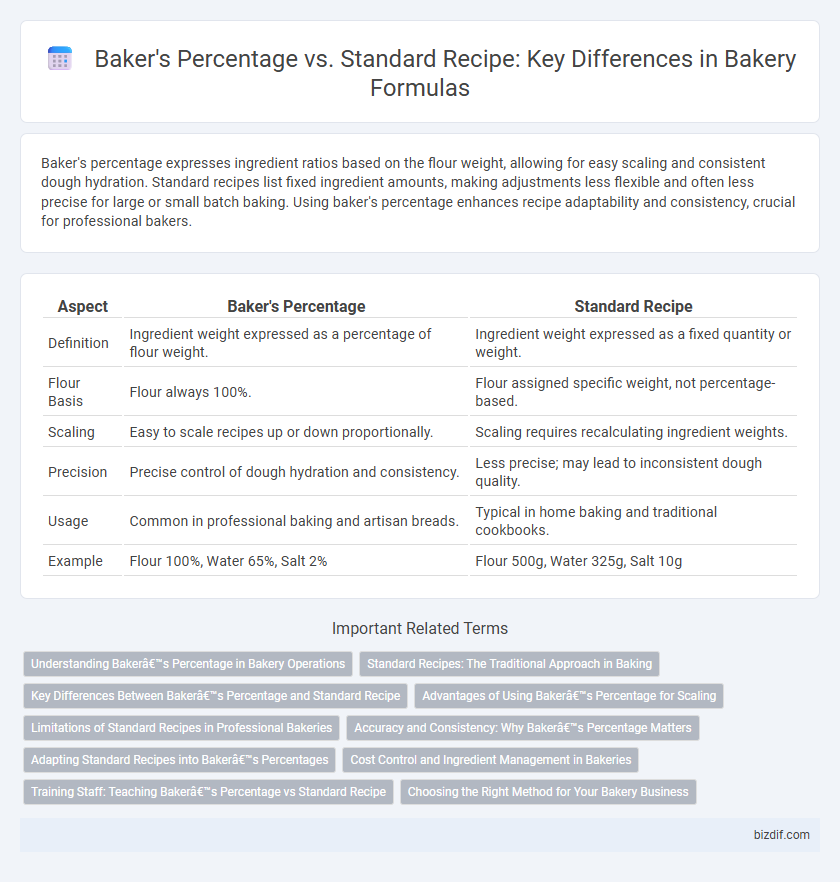Baker's percentage expresses ingredient ratios based on the flour weight, allowing for easy scaling and consistent dough hydration. Standard recipes list fixed ingredient amounts, making adjustments less flexible and often less precise for large or small batch baking. Using baker's percentage enhances recipe adaptability and consistency, crucial for professional bakers.
Table of Comparison
| Aspect | Baker's Percentage | Standard Recipe |
|---|---|---|
| Definition | Ingredient weight expressed as a percentage of flour weight. | Ingredient weight expressed as a fixed quantity or weight. |
| Flour Basis | Flour always 100%. | Flour assigned specific weight, not percentage-based. |
| Scaling | Easy to scale recipes up or down proportionally. | Scaling requires recalculating ingredient weights. |
| Precision | Precise control of dough hydration and consistency. | Less precise; may lead to inconsistent dough quality. |
| Usage | Common in professional baking and artisan breads. | Typical in home baking and traditional cookbooks. |
| Example | Flour 100%, Water 65%, Salt 2% | Flour 500g, Water 325g, Salt 10g |
Understanding Baker’s Percentage in Bakery Operations
Baker's percentage is a method used in bakery operations to express ingredient ratios based on the flour weight, where flour is always 100%, allowing for precise scaling and consistency across recipes. This system contrasts with standard recipes that use fixed ingredient amounts, which can be less adaptable to batch size changes and ingredient variability. Understanding baker's percentage helps bakers optimize dough hydration, fermentation, and overall product quality by accurately adjusting ingredient proportions.
Standard Recipes: The Traditional Approach in Baking
Standard recipes in baking rely on fixed ingredient quantities measured by weight or volume, ensuring consistent results in traditional bread and pastry preparation. Unlike Baker's percentage, which expresses ingredients as a percentage of flour weight for scalability and precision, standard recipes focus on exact amounts for straightforward use in home kitchens. This traditional approach simplifies replication but may lack the flexibility and adaptability required for large-scale or variable recipe adjustments.
Key Differences Between Baker’s Percentage and Standard Recipe
Baker's percentage expresses ingredient ratios based on the flour weight, facilitating scalable and precise adjustments in baking formulas, while standard recipes list ingredients by fixed quantities or volume measurements. Unlike standard recipes, baker's percentage allows bakers to compare and modify dough hydration, yeast, and salt levels easily for consistent results across varying batch sizes. This method improves accuracy in professional baking environments, promoting uniform texture and flavor in bread production.
Advantages of Using Baker’s Percentage for Scaling
Baker's percentage offers precise control over ingredient ratios by expressing each component relative to the flour weight, enabling consistent scaling across different batch sizes without altering dough characteristics. This method simplifies recipe adjustments for varying production volumes, ensuring uniform texture, flavor, and fermentation outcomes. Standard recipes lack this flexibility, often causing inconsistencies when increasing or decreasing quantities.
Limitations of Standard Recipes in Professional Bakeries
Standard recipes often rely on fixed ingredient quantities, which can lead to inconsistencies in dough hydration and texture when ingredients like flour vary in moisture content or protein levels. Baker's percentage allows for precise scaling and adaptation by expressing each ingredient as a percentage of flour weight, ensuring consistent results regardless of batch size. This flexibility is crucial in professional bakeries where ingredient variability and production volume demand exact formulation adjustments to maintain product quality.
Accuracy and Consistency: Why Baker’s Percentage Matters
Baker's percentage provides precise ingredient ratios based on the flour weight, ensuring accuracy in scaling recipes regardless of batch size. This method enhances consistency by allowing bakers to maintain the exact proportions necessary for predictable dough texture and product quality. Unlike standard recipes, baker's percentage eliminates guesswork, making it essential for professional and commercial baking.
Adapting Standard Recipes into Baker’s Percentages
Adapting standard recipes into baker's percentages allows bakers to scale ingredients accurately based on the total flour weight, ensuring consistent dough hydration and texture. In baker's percentages, flour is set at 100%, and all other ingredients are expressed as a percentage of the flour weight, providing precision in recipe adjustments. This method simplifies recipe scaling, ingredient substitutions, and enhances control over the baking process for professional and home bakers alike.
Cost Control and Ingredient Management in Bakeries
Baker's percentage allows precise cost control by expressing each ingredient as a percentage of the flour weight, enabling bakeries to easily scale recipes and manage ingredient usage efficiently. This method simplifies inventory management and cost calculation, reducing waste and ensuring consistent product quality across different batch sizes. Standard recipes, while useful for consistency, often lack flexibility in adjusting ingredient quantities for cost optimization in dynamic bakery operations.
Training Staff: Teaching Baker’s Percentage vs Standard Recipe
Training staff in baker's percentage enhances their understanding of ingredient ratios by expressing each component as a percentage of flour weight, fostering consistent scaling and recipe modification. Unlike standard recipes that list fixed ingredient amounts, baker's percentage provides flexibility for adjusting batch sizes and ingredient substitutions without compromising dough quality. Mastery of baker's percentage equips bakers with critical skills for precision, efficiency, and adaptability in professional bakery operations.
Choosing the Right Method for Your Bakery Business
Baker's percentage provides a flexible and scalable approach by expressing ingredient ratios relative to flour, enabling consistent results across varying batch sizes in bakery production. Standard recipes list fixed quantities for ingredients, which can simplify initial recipe development but may lack adaptability for scaling or ingredient substitutions. Selecting Baker's percentage is ideal for bakeries seeking precision and consistency in product quality, while standard recipes suit small-scale or home-based operations prioritizing simplicity.
Baker’s percentage vs Standard recipe Infographic

 bizdif.com
bizdif.com